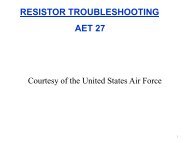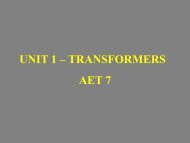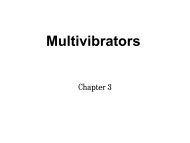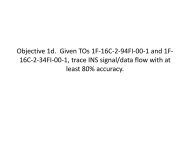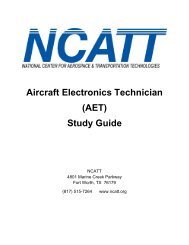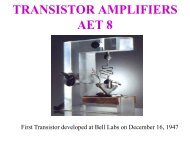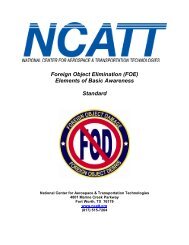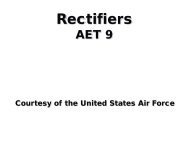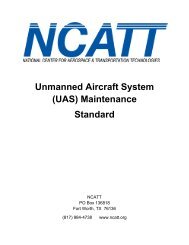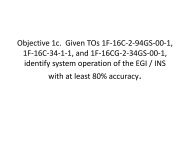Aircraft Electronics Technician AET - NCATT
Aircraft Electronics Technician AET - NCATT
Aircraft Electronics Technician AET - NCATT
Create successful ePaper yourself
Turn your PDF publications into a flip-book with our unique Google optimized e-Paper software.
<strong>NCATT</strong> <strong>Aircraft</strong> <strong>Electronics</strong> <strong>Technician</strong> (<strong>AET</strong>) Study Guide<br />
• Voltmeter<br />
o Used to find a circuit problem with power on the circuit<br />
o When checking for zero output voltage, a good starting point is to check the input<br />
with a voltmeter<br />
• Ammeter<br />
o Used to find a circuit problem with power on the circuit<br />
o Millimeters and micro ammeters measure very small rates of current flow<br />
• Ohmmeter<br />
o Used to find a circuit problem when power is removed from the circuit<br />
o Ohmmeters measures resistance<br />
• Oscilloscope<br />
o Measures and displays voltage (AC peak-to-peak values) in waveforms (output)<br />
of a wave generating circuit<br />
o See Use Test Equipment/Special Tools<br />
Basic Troubleshooting Theory:<br />
• Continuity Check/Test<br />
o Checks for the existence of a complete electrical system between two points<br />
o Most of the time, a voltmeter or ohmmeter is used to test the continuity of a<br />
circuit<br />
o Tests should be made at each terminal of the circuit to isolate the problem<br />
Steps in the Troubleshooting Process:<br />
• Isolate the problem<br />
o Is the equipment being operated properly<br />
o Is the problem ongoing<br />
o Is the problem intermittent<br />
o Is the problem worse during taxi<br />
o Is the problem worse during takeoff<br />
o Does the problem exist while cruising<br />
o Is the problem worse during landing<br />
o Is the software loaded properly<br />
o What impact does weather have on the problem<br />
• Check for the obvious<br />
o Are there any loose connections<br />
o Loose or broken wiring<br />
o Bent or Frayed wiring<br />
o Inoperative indicator lights<br />
o Are there bad electrical bonds<br />
o Broken or cracked parts<br />
o Anything punctured<br />
Copyright © 2012 by the National Center for Aerospace & Transportation Technologies. All rights reserved. Individuals may<br />
download, print, and make copies of this document for their own personal use. Commercial use prohibited.<br />
Page 11 of 60




